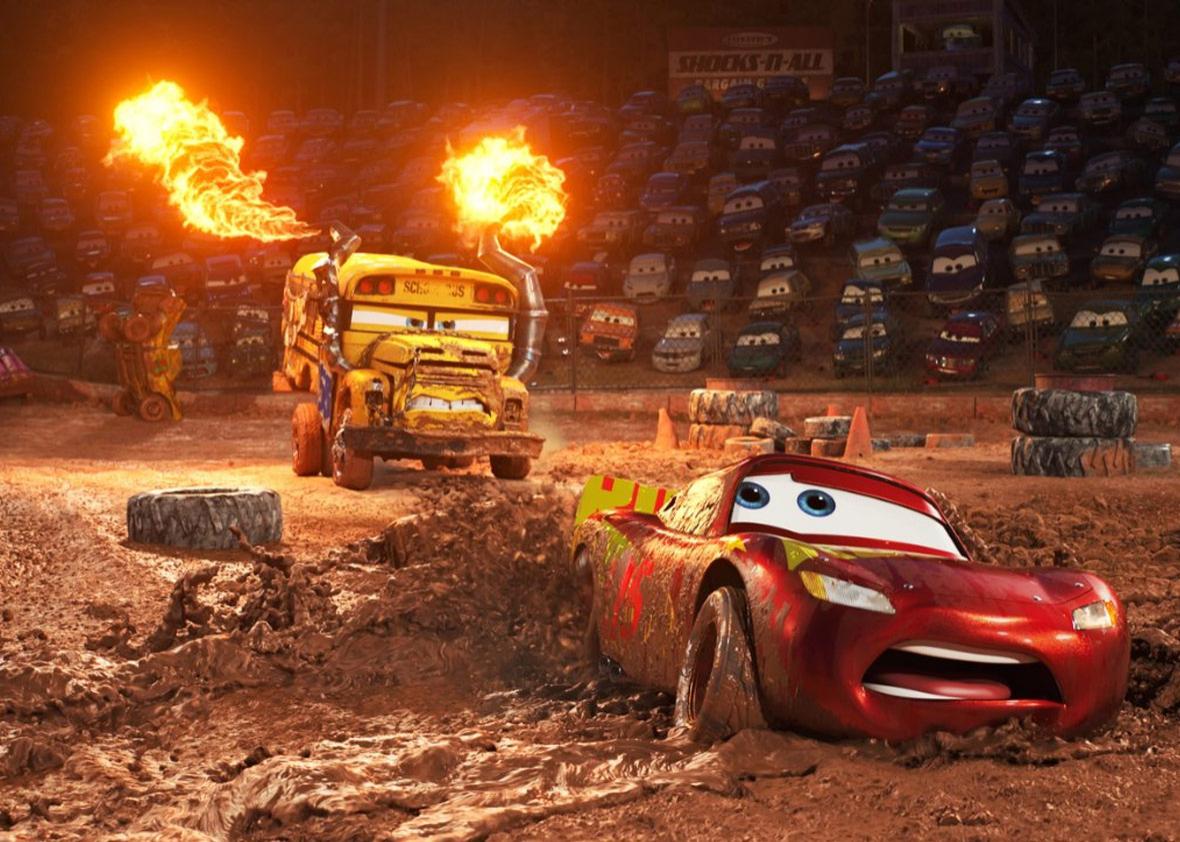Cars was the first movie to show that Pixar had feet of clay, so when it came time to announce a follow-up, the studio promised it would be different from the first, and it made good on that promise by opening Cars 2 with a spy-movie sequence featuring none of the first movie’s familiar characters. Cars 3 likewise begins with a promise to be nothing like its predecessor, but in this case, it’s a retreat to familiar territory rather than a step onto virgin soil. From a merchandising standpoint alone, another Cars movie was probably inevitable; rare is the playground visit that does not involve a glimpse of Lightning McQueen’s yellow-on-red color scheme. But Cars 2’s place at the bottom of virtually every Pixar ranking (except those put together by children) nonetheless seems to have made an impression. Opening with Lightning McQueen (voiced by Owen Wilson) reciting his pre-race mantra over a black screen, the new movie re-creates the beginning of the first one beat for beat, as if to reassure its audience that we’re not going to spend the succeeding two hours watching rusted-out hick Mater (Larry the Cable Guy) foil another international conspiracy. Cars 3 is the Cars sequel for people who hate Cars 2.
The retread at least has some thematic heft. Cars 3 is a pass-the-torch sequel, of the kind that’s usually designed to let franchises continue after their leads have aged out of the role. (That’s true behind the camera as well: Pixar head John Lasseter cedes the director’s chair to storyboard artist Brian Fee.) Animation knows no such restraints—cartoons can go on living long after the actors who created their voices—but the specter of mortality haunts the movie all the same. Lightning is drifting into middle age, whatever that is in automobile years, and a new generation of younger, faster cars are nipping at his fenders. He’s still active on the racing circuit, but even the terms his fans use to describe him—veteran, legend, elder statesman—underline the fact that he’s nearing the end of his career. A new sponsor, a brash billionaire named Sterling (Nathan Fillion), sets him up with a high-tech workout facility and a sleek young trainer, Cruz Ramirez (Cristela Alonzo), who’s oblivious to the way it stings when she gushes that she grew up watching Lightning race. But virtual racetracks aren’t Lightning’s speed, so he sets out to find his former mentor’s crew chief, a sturdy old truck named Smokey (Chris Cooper), who reminds him what he was racing for in the first place.
Although it’s only been 11 years since Cars, a number of its actors have died, including Paul Newman, whose gruff voice lent a weary gravitas to the role of Doc Hudson, a former champion racer who sought anonymity in the backwater town of Radiator Springs. Newman died in 2008 and was memorialized in the second film, but his character returns for Cars 3, with dialogue cribbed from the first movie’s recording sessions. Since Doc’s scenes are all flashbacks or visions, the recycling is fairly unobtrusive, but the reappearance of Lightning’s old sponsors, Dusty and Rusty of the bumper ointment company Rust-eze, played by Car Talk’s Ray and Tom Magliozzi, isn’t handled so smoothly. If you know that Tom, the co-host of the popular NPR program, died in 2014, it’s conspicuous, even jarring, how his character hovers silently off to the side as his brother talks, only occasionally chuckling in unison—the Pixar equivalent of how Rogue One brought Peter Cushing back from the dead.
The Cars franchise has always been Pixar’s attempt to woo the NASCAR crowd, and even if the studio’s got a tin ear for contemporary country stars, the first movie’s paean to small-town life went deeper than demographic pandering. But in Cars 3, the focus starts to shift. There’s no race or ethnicity in the Cars universe—one make is as good as another—but it’s clear that the others cars regard Alonso’s Cruz as different, and she goes along with them. (She may be the first car to suffer from impostor syndrome.) Lightning shuts her out as well, as deaf to the younger generation in this movie as he was to his elders in the first, but he starts to realize that the world is changing and that the future should not belong only to hotshots like Armie Hammer’s Jackson Storm, whose cocky rookie is the mirror image of a young Lightning McQueen. It’s fitting that Pixar’s next movie will be Coco, its first with an all-Latino cast. Not even the universe of anthropomorphic cars looks the way it used to.
Cars 3 is still lower-tier Pixar. The studio’s level of craft is so high and so consistent that it’s not always easy to pinpoint what separates a good Pixar movie from a just-OK one. But the Cars movies feel more mechanical than most of Pixar’s product, and not just because their protagonists have engines where their hearts should be. They’re built from scrap, welded together from other movies whose parts never quite fit together. That’s why their best, most loyal, audience is children, who either don’t know their predecessors or are comforted by their familiarity. Grown-ups may roll their eyes—even if they do get a little misty at the end—but by the 50th viewing or so, they’ll be grateful for its reliable mediocrity.
